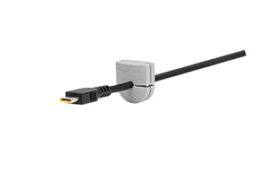Power over Ethernet (PoE) began the trend of simplifying network cabling by combining power and communication in network cabling. Now, EtherCAT offers a combined version.
Thomas Rettig, Senior Product Manager, EtherCAT Technology, Beckhoff Automation
On its own, EtherCAT is an established global standard. A newer version, EtherCAT P, combines the fast EtherCAT communication with 24 V power for the system and peripherals in an Ethernet cable. This development means that “One Cable Automation” (OCA) can now be implemented at the field level, enabling the plug-and-play connectivity for machines and other equipment, ranging from 24 V sensors to 600 V drives without the need for control cabinets.

EtherCAT P combines the 24 Vdc power supply for EtherCAT P slaves with connected sensors and actuators in a single 4-wire standard Ethernet cable. US (system and sensor supply voltage) and UP (peripheral voltage for actuators) are electrically isolated from each other and can supply current of up to 3 A to connected EtherCAT P components.
With EtherCAT P, the US and UP currents are directly fed into the wires of the 100 Mbit/s line, streamlining network and power architectures. This configuration makes EtherCAT P a suitable protocol for sensors, actuators and measurement technology components with benefits for connecting small I/O stations in the terminal box, as well as for distributed I/O components. Beckhoff developed a special M8 connector for the cable that provides mechanical encoding and prevents any confusion with connectors for standard EtherCAT slaves.
A complete EtherCAT P connector family connects components with higher voltage and current needs, to cover applications up to drives with 400 Vac or 600 Vdc and up to 64 A ratings. The new connectors make it easy to connect field-level components.
For I/O applications, the interfaces are available with IP 20 and IP 67 ratings. The EtherCAT P system is also suitable for ac and dc motors, actuators, valve terminals and sensors such as proximity switches, light barriers or rotary encoders. For vision applications, users can connect cameras, barcode scanners and 3D scanners.
EtherCAT P simplifies system wiring
The fundamental idea of EtherCAT P is to simplify system wiring by reducing the number of connectors on automation components and devices. The one-cable solution, which is scalable to individual power requirements, can be deployed throughout the entire field level. For 24 V applications, a standard Ethernet cable can be used. For higher voltages and currents, EtherCAT P is integrated into the respective power supply line.
Eliminating separate power lines reduces the cost of materials and assembly, as well as the risk of installation errors. It also minimizes the space requirements for cable routes, in control cabinets, and in the machine itself. Other benefits include smaller and more precisely arranged cable runs, as well as smaller sensors and actuators. Such benefits give machine manufacturers and plant personnel more design options while minimizing hardware and system costs through a convenient, tool-assisted system layout.
Flexible topology through power supply forwarding
Linear, star and tree structures can be freely combined to achieve cost-effective and efficient system layouts. Unlike with classic Power over Ethernet (PoE), EtherCAT P devices can also be cascaded and supplied by a single feed-in device. The voltage drop limits cascading of EtherCAT P devices, but this can be remedied with additional power feed-in points.
To build custom EtherCAT P topologies, infrastructure and I/O components with IP 20 and IP 67 ratings are available. Since EtherCAT P distances of 50 meters and more can be bridged, even widely distributed machine modules can be easily linked.
A seamless shift from an EtherCAT to an EtherCAT P network is also possible. Conversely, system and peripherals voltage on an EtherCAT P network can be blocked with a simple adapter to run EtherCAT devices with their own power supply.
A tool in TwinCAT software helps designers plan or configure cable lengths for a machine design. Since the system knows the data of all users, it can also take the individual devices’ power consumption over time into account. For example, if a system operates such that two actuators never switch at the same time, they never require full power at the same time. This capability produces additional savings potential concerning feed-ins and power supply units.
One Cable Automation for the field level
EtherCAT P was developed to establish One Cable Automation across the field level. This simpler system cabling makes machine designs less complex while reducing engineering and production costs. It lets designers use a single cable to deliver power and control signals to automation components, distributed terminal boxes, machine modules and robots. Large control cabinets can be reduced in size or even eliminated. As a result, modular machine and system concepts can now be implemented with lower assembly and startup costs, reduced footprints and greater flexibility.
Pluggable technologies will deliver maximum automation efficiency in the future. As EtherCAT P connectors for various power requirements become established, the idea of industrial connector strips for 24 V and higher power classes is not farfetched, but a viable solution. Machine designers could distribute such strips with great flexibility and at low cost in a machine or plant installation according to the individual application requirements. Such a plug-and-play design that requires only the insertion of a matching EtherCAT cable would make it easy to connect all required sensors and actuators as well as distribution boxes and standalone machine modules.
Beckhoff Automation
www.beckhoff.com/ethercatp
Filed Under: CONNECTIVITY • fieldbuses • networks, Encoders (rotary) + resolvers





Tell Us What You Think!